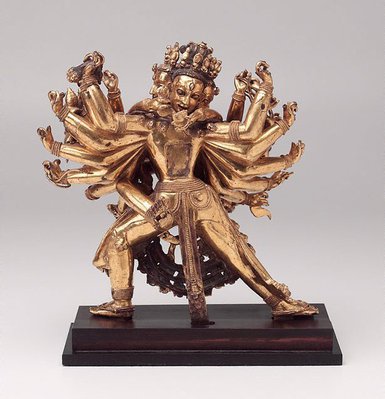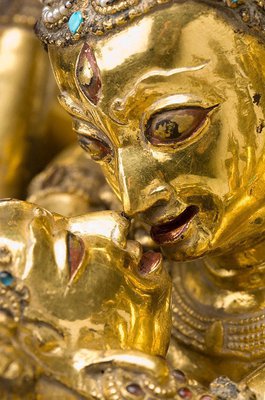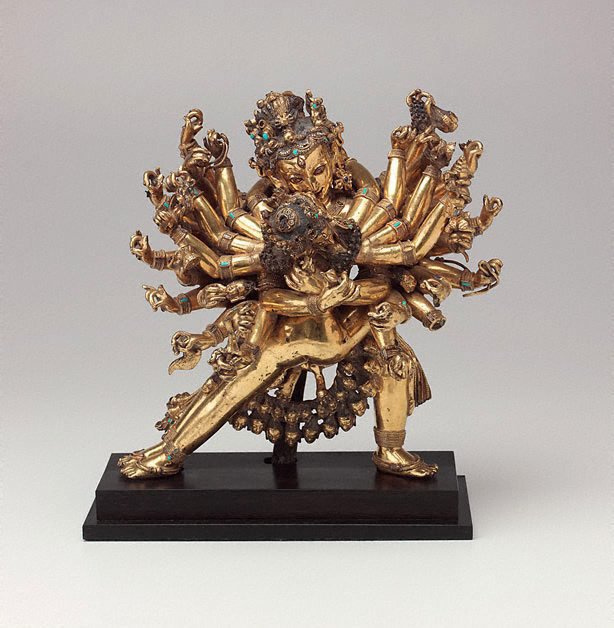


-
Details
- Other Title
- Tibetan kalachakra statue
- Alternative title
- Tibetan kalachakra statue
- Place where the work was made
-
Lhasa
→
Tibet
- Date
- 14th century-15th century
- Media category
- Sculpture
- Materials used
- bronze, gold leaf, gemstones
- Dimensions
- 29.8 cm
- Signature & date
Not signed. Not dated.
- Credit
- Purchased with funds provided by the Asian Art Collection Benefactors and VisAsia 2005
- Location
- South Building, lower level 1, Asian Lantern galleries
- Accession number
- 7.2005
- Copyright
- Share
-
-
About
In June 2022, the Art Gallery became aware of claims that this sculpture was illegally removed from Tibet after 1995. It passed through private collections before being purchased by the Art Gallery in 2005. We are working with relevant researchers and authorities to gather further details and determine the appropriate course of action. If you know more about the provenance of this sculpture, or other works in the Art Gallery’s collection, please share your knowledge with us: provenance@ag.nsw.gov.au
This extraordinary sculpture shows the Buddha couple Kalachakra and Vishvamata locked in passionate embrace, lovingly gazing at each other. Both figures are four-headed, with the lips and eyes on each face marked with pigments, lending added naturalism to the sculpture. Typical of Heruka Buddhas, Kalachakra strikes an energetic, lunging pose and Vishvamata mirrors his stance. Both figures wear elaborate jewellery, studded with brilliant blue turquoise and inlaid with semi-precious stones. The delicate festoon of pearls that hangs from Kalachakra’s headdress deserves particular attention.
Kalachakra’s twenty-four hands and Vishvamata’s eight, surrounding the couple like a golden aura, each originally held an attribute. Among the objects that survive in Kalachakra’s hands are the ‘vajra’ and bell, a partially broken sword, a flaying knife, a double-sided pellet drum, the Buddhist wheel, a ‘vajra’-tipped noose, a conch shell and a gem-encrusted jewel. In Kalachakra’s uppermost raised hand dangles the severed head of the four-faced Hindu god Brahma (‘Brahmakapala’). Although seemingly gruesome, this attribute symbolises Kalachakra’s infinite compassion towards all beings (Beer 1999: 309). Vishvamata holds a flaying knife and skull cup in her main hands hidden behind Kalachakra’s neck. Other implements that remain in her additional hands include a noose, a pellet drum, a lotus and a jewel. The figures’ striking pose, the intimacy they share and the dazzling display of arms create a dynamic tour de force.
Chaya Chandrasekhar, ‘Goddess: divine energy’, pg.252.
-
Exhibition history
Shown in 6 exhibitions
Symbols of Buddhism: Sculpture and Painting from India and the Himalayas, Dickinson Roundell Inc., New York, 18 Mar 2002–26 Mar 2002
Goddess: Divine Energy, Art Gallery of New South Wales, Sydney, 13 Oct 2006–28 Jan 2007
One hundred flowers (2011), Art Gallery of New South Wales, Sydney, 01 Sep 2011–15 Jan 2012
Conversations through the Asian collections, Art Gallery of New South Wales, Sydney, 25 Oct 2014–13 Mar 2016
Walking with gods, Art Gallery of New South Wales, Sydney, 01 Jun 2019–05 Jan 2020
Elemental, Art Gallery of New South Wales, Sydney, 30 Jul 2022–2024
-
Bibliography
Referenced in 8 publications
-
Edmund Capon AM, OBE, Art Gallery of New South Wales: highlights from the collection, Sydney, 2008, 182 (colour illus.).
-
Chaya Chandrasekhar, Look, 'Kalachakra', pg. 24-27, Sydney, Mar 2006, front cover (colour illus., detail), 24 (colour illus.), 25 (colour illus.), 26-27 (colour illus., detail).
-
Chaya Chandrasekhar, Goddess: Divine Energy, 'Heruka Buddha couples', pg. 243-255, Sydney, 2006, 252, 253 (colour illus.). cat.no. 158
-
Gyurme Dorje (Editor), Jokhang. Tibet’s Most Sacred Buddhist Temple, London, 2009, 267 (colour illus.). plate 16c. Photograph taken by Ulrich von Schroeder.
-
Susan Owens, The Weekend Australian Financial Review, 'Mystique of the Orient', pg. 31, Sydney, 22 Oct 2005-23 Oct 2005, 31 (colour illus., detail).
-
Jane Casey Singer, Symbols of Buddhism: Sculpture and Painting from India and the Himalayas, 'Kalacakra', London, Mar 2002, (colour illus.). cat.no.7
-
Jill Sykes (Editor), Look, Sydney, Nov 2005, 11 (colour illus., detail).
-
Ulrich von Schroeder, 108 Buddhist statues in Tibet, Chicago, 2008, (colour illus.). Illustration appears in the accompanying DVD.
-
-
Provenance
George Ortiz, 1990s-2002, Switzerland
Jokhang Temple Monastery, 1990s, Lhasa/Tibet, as photographed by Ulrich von Schroeder and published in 'Jokhang. Tibet's most sacred Buddhist temple' Thames & Hudson, 2010, p 267.
Rossi & Rossi, Feb 2005, London/England, purchased through Rossi & Rossi (art dealership), London by the Art Gallery of New South Wales, Sydney, Feb 2005.
